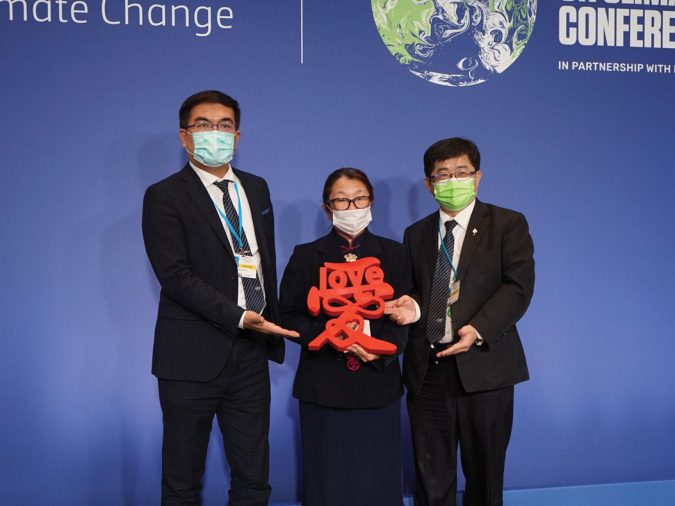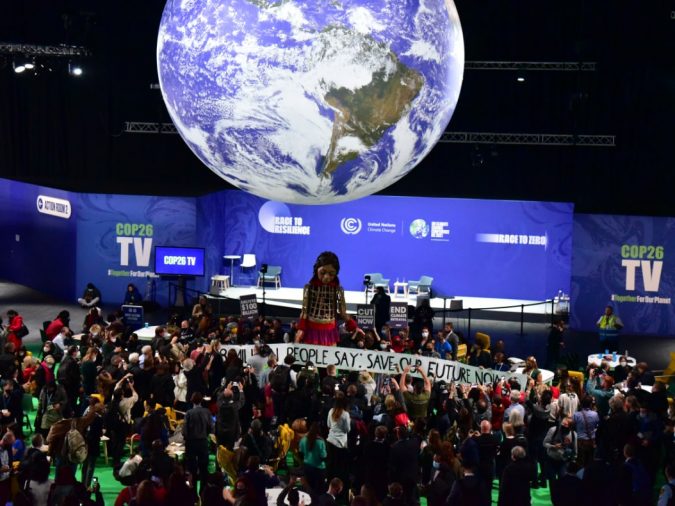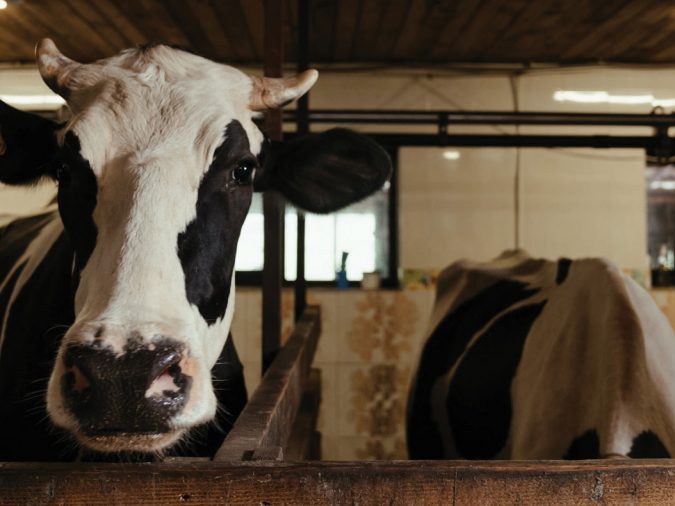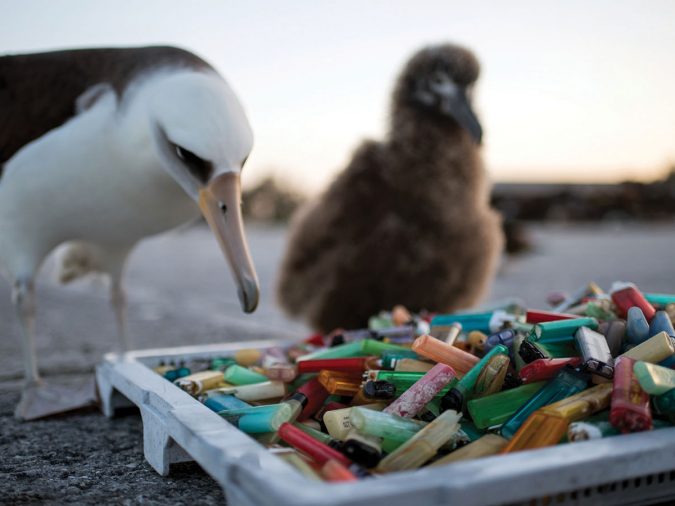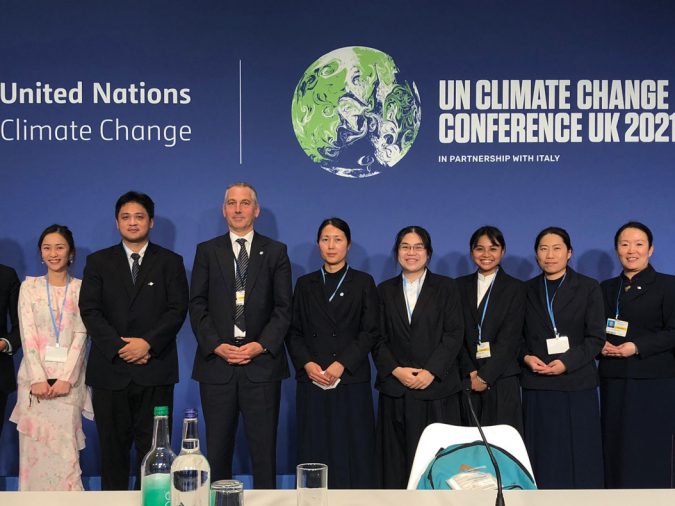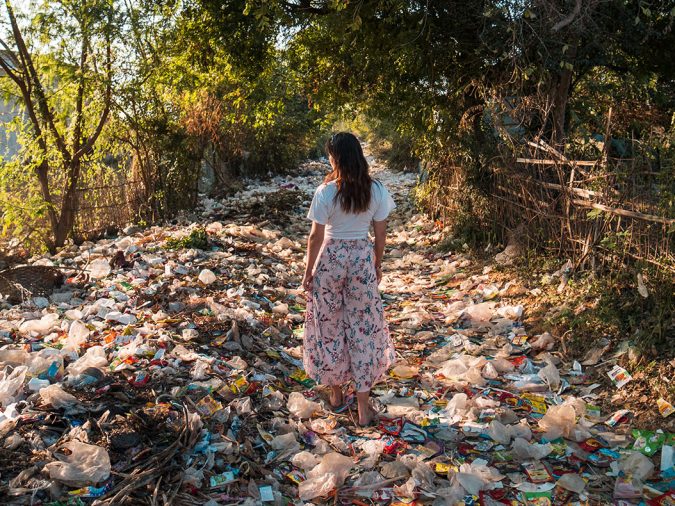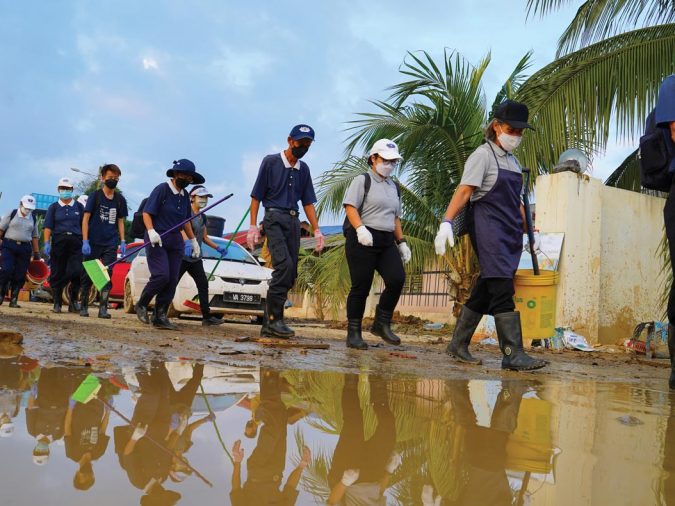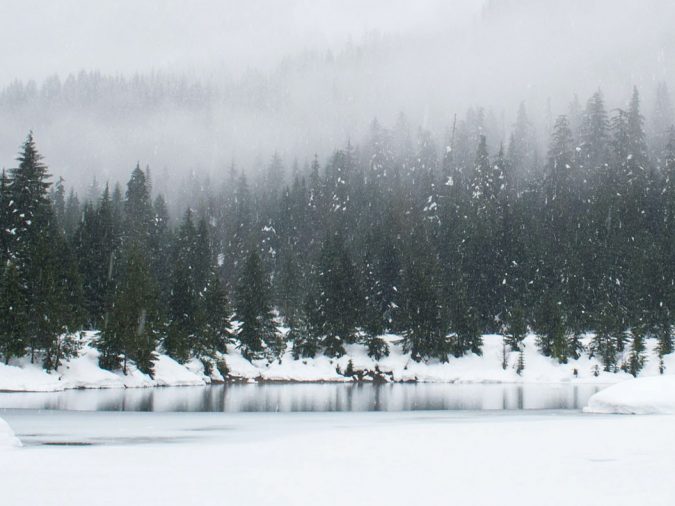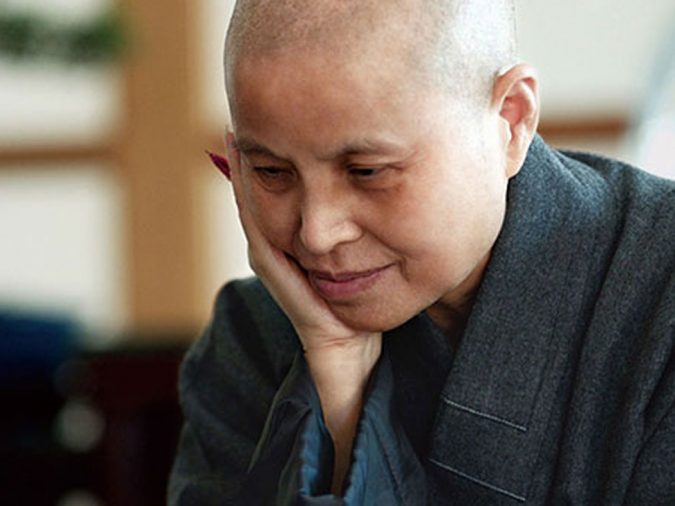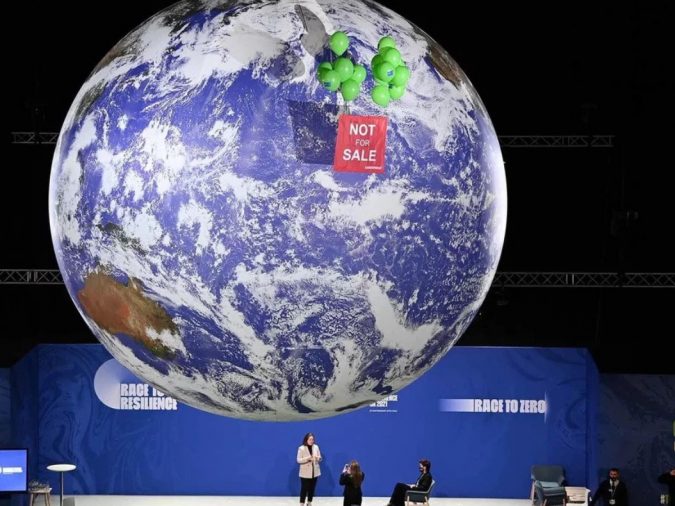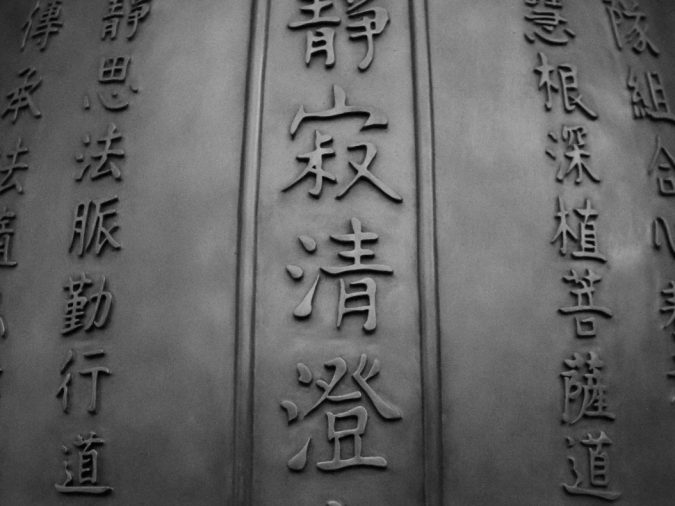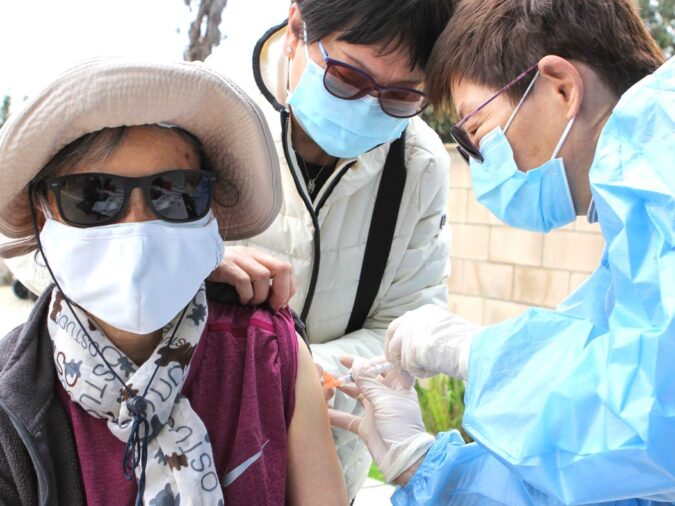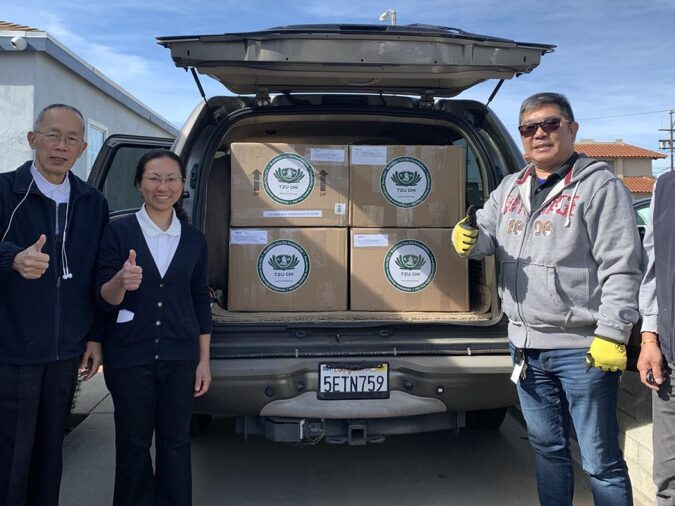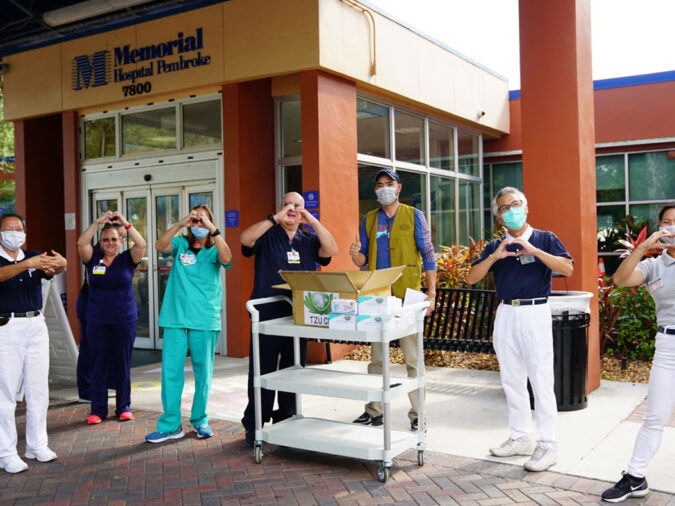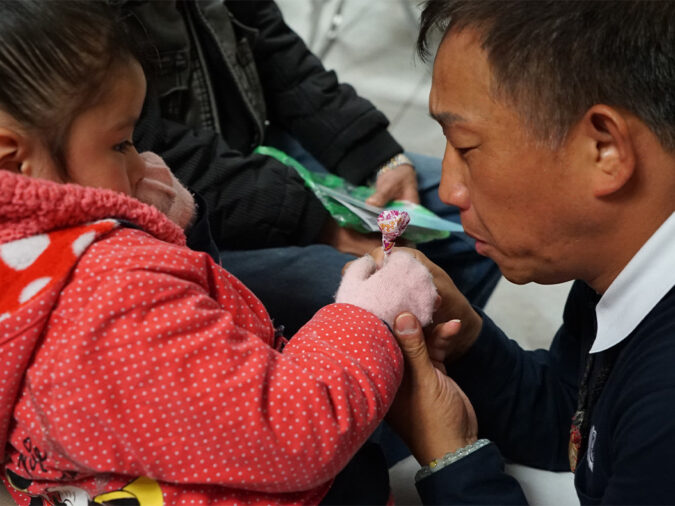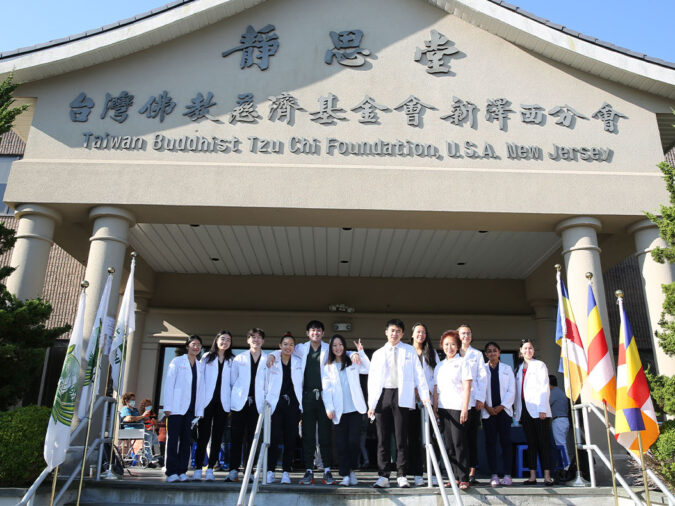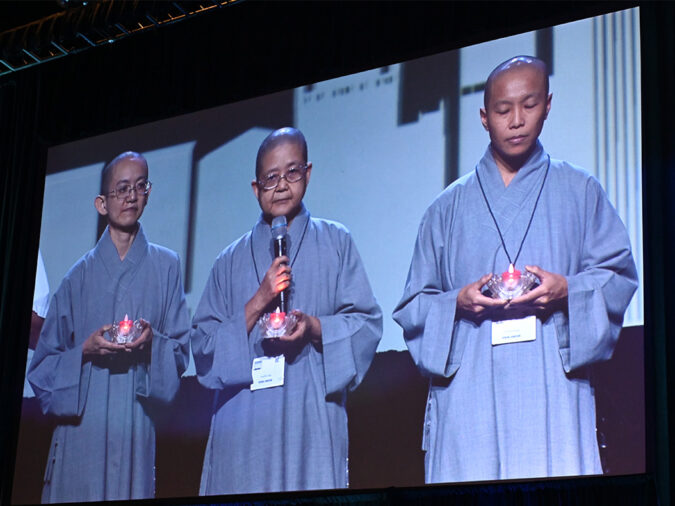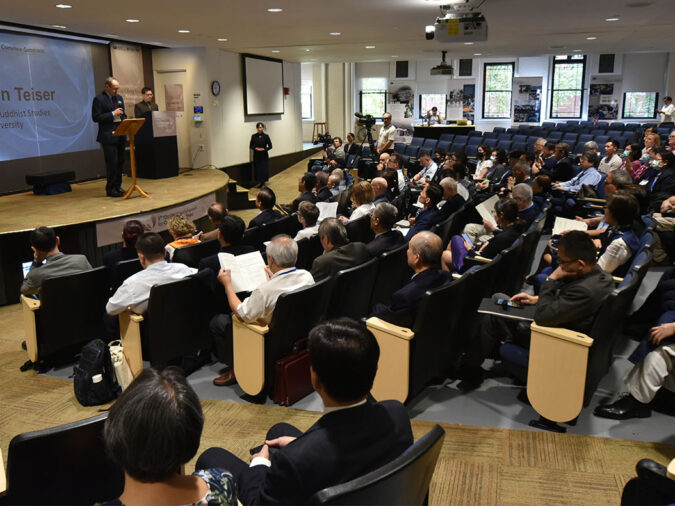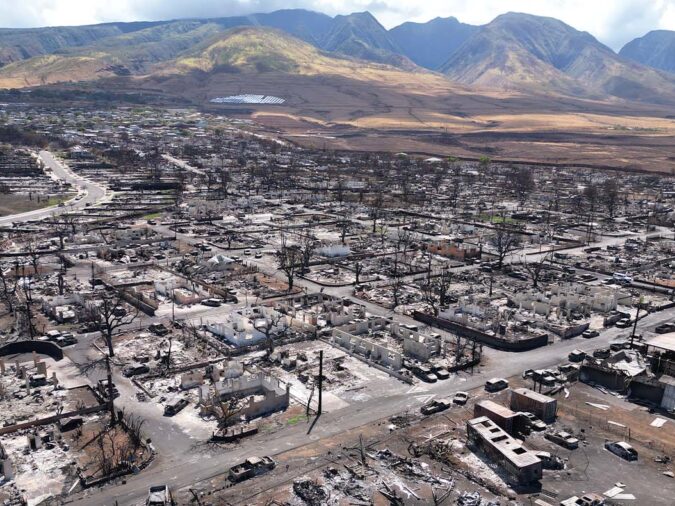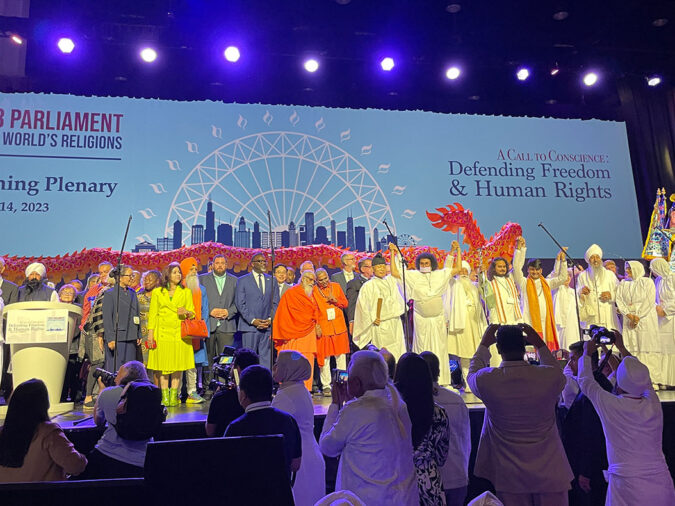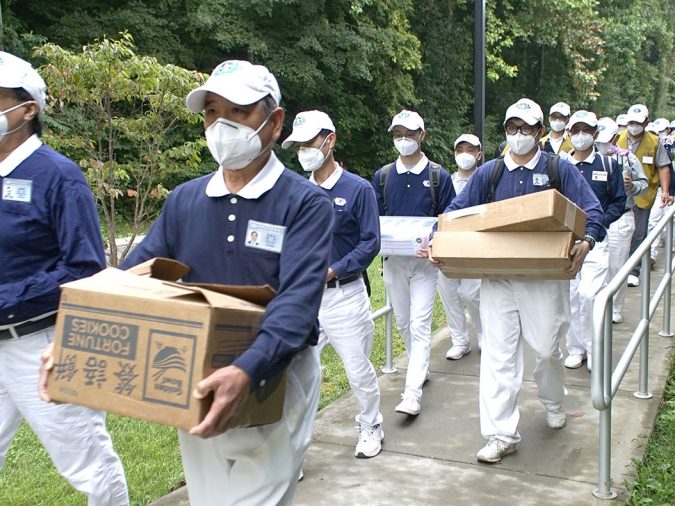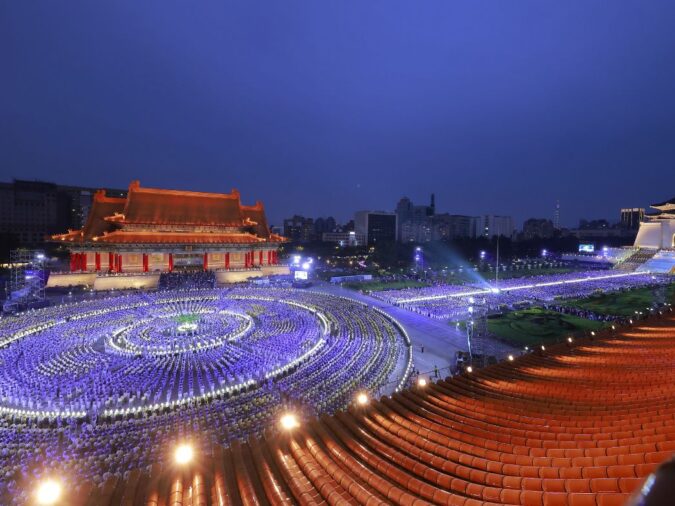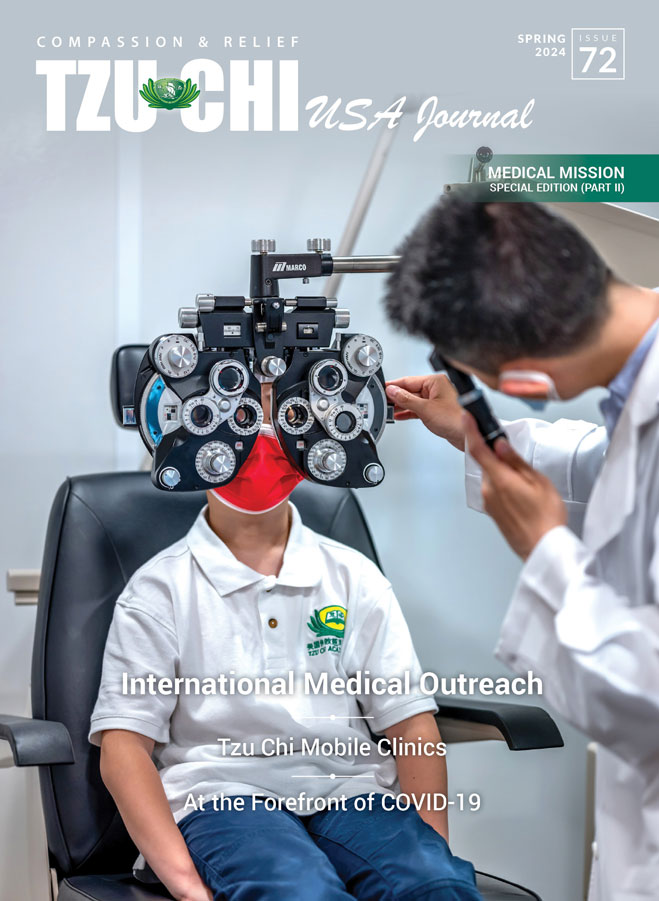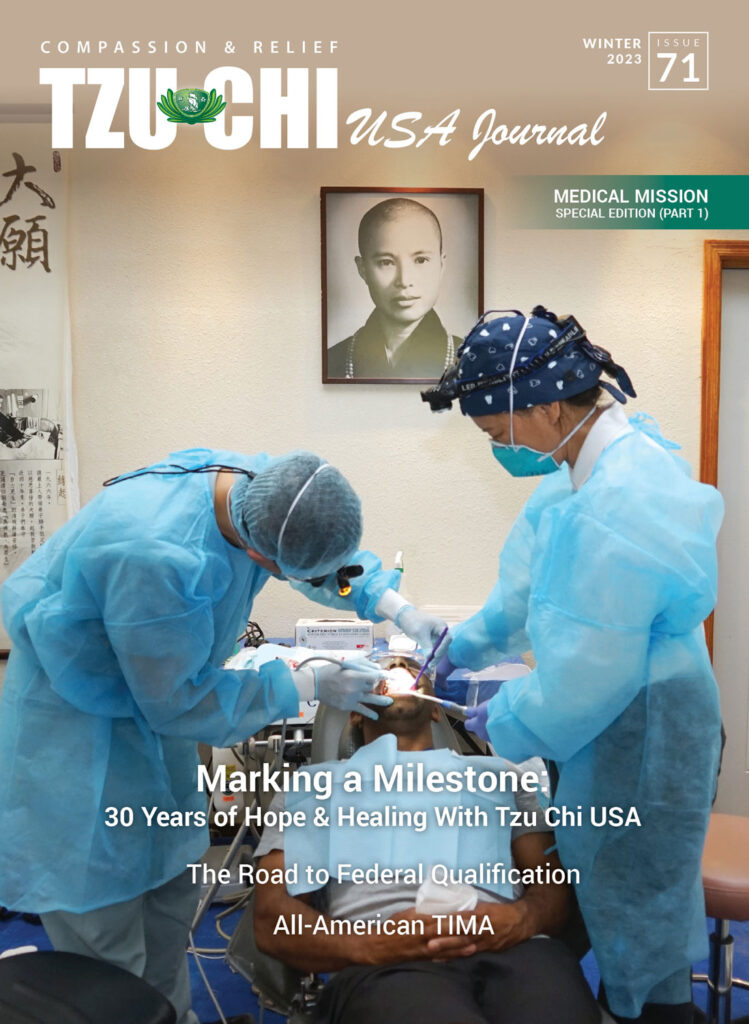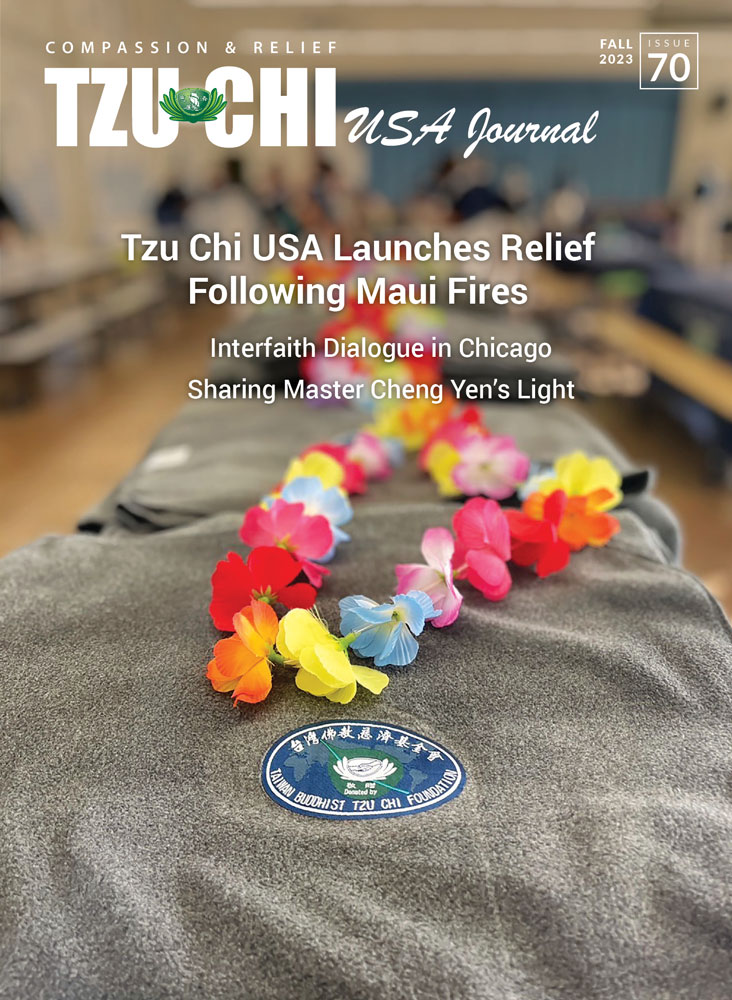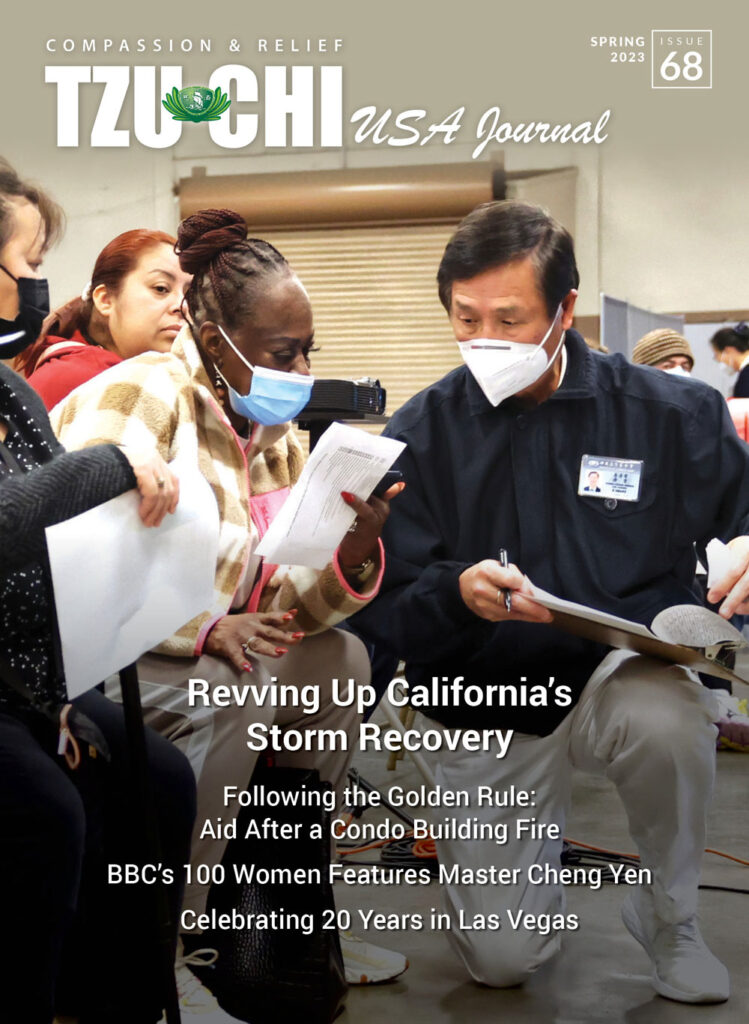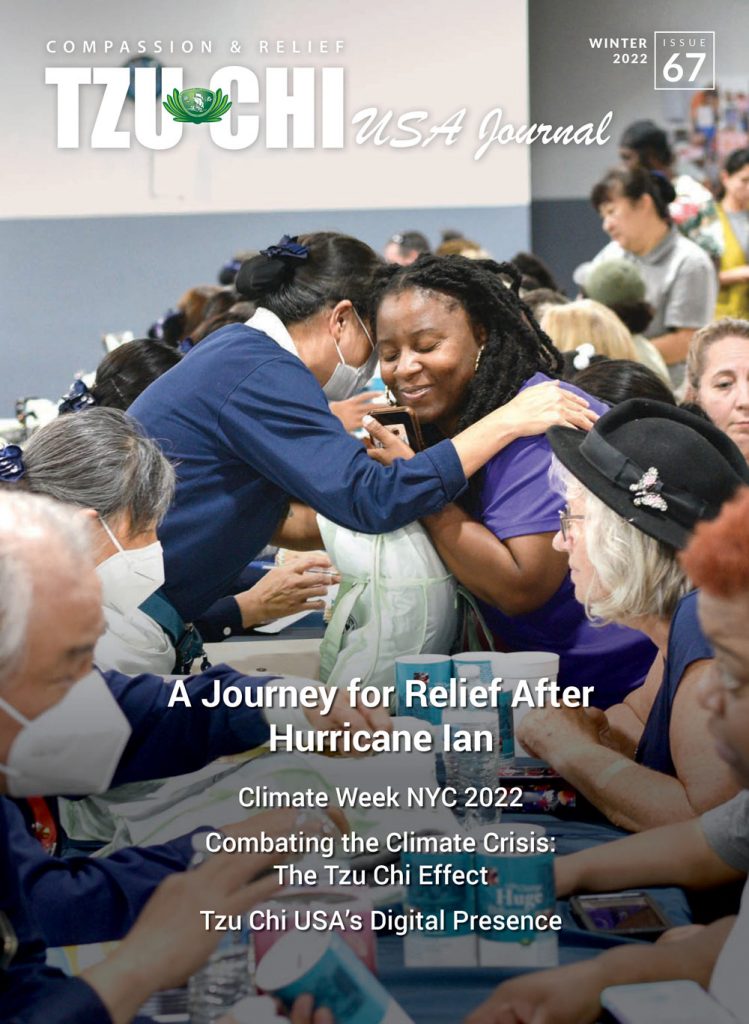Tzu Chi at COP26:
Calling for Individual Action on Climate Change
(Part 3)
Tzu Chi at COP26: Part 3 – Calling for Individual Action on Climate Change
By Ida Eva Zielinska
Photos by Tzu Chi SDG Action Team
Published #64 | Spring 2022 Issue
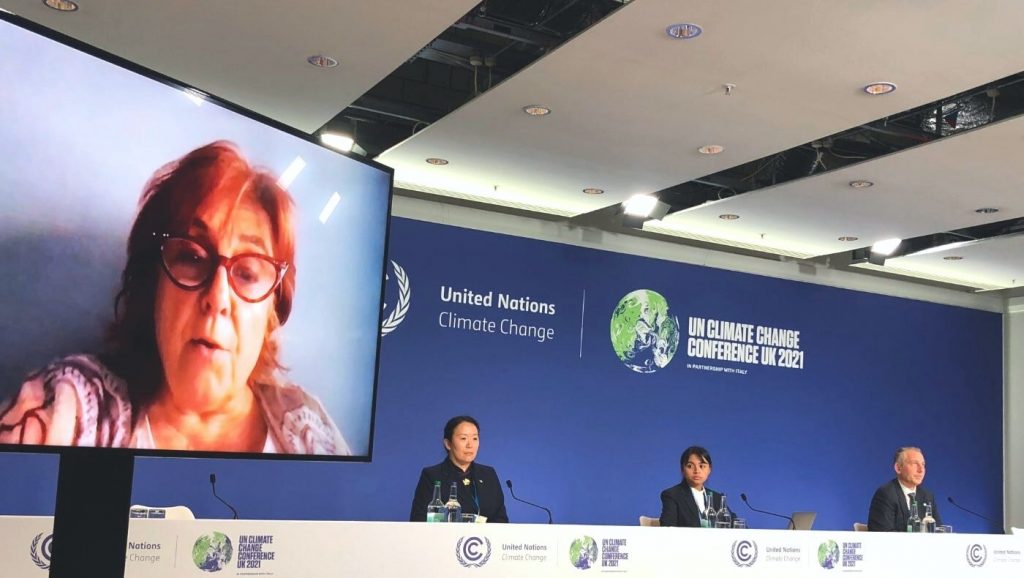
Dr. Cristina Tirado brings added statistics to the table.
SHARE
9. Learning About Scotland’s Renewable Energy Success
While UNFCCC members took a break from deliberations on Sunday, November 7, many delegates, including the Tzu Chi team, ventured out to Whitelee Windfarm, Scotland’s primary renewable energy source, located in Glasgow’s suburbs. Scotland could be taken as a source of inspiration, as it has one of the world’s most ambitious climate targets, aiming to reach net-zero by 2045. By 2020, renewables had already met 97.4% of the country’s electricity demand, with onshore wind delivering about 70% of capacity, followed by hydro and offshore wind.
ScottishPower decided to move into clean energy a long time ago and has been involved in renewables for over 20 years now, Denise Robertson, Head of Media Relations, explained: “A cleaner, greener future is really important to all of us now. We’re in a climate emergency, and people get that probably for the first time; they understand the difference.” Whitelee Windfarm, created in 2009, is the largest onshore wind farm in the UK and generates enough clean energy to power around 350,000 homes, which is more than every home in Glasgow.
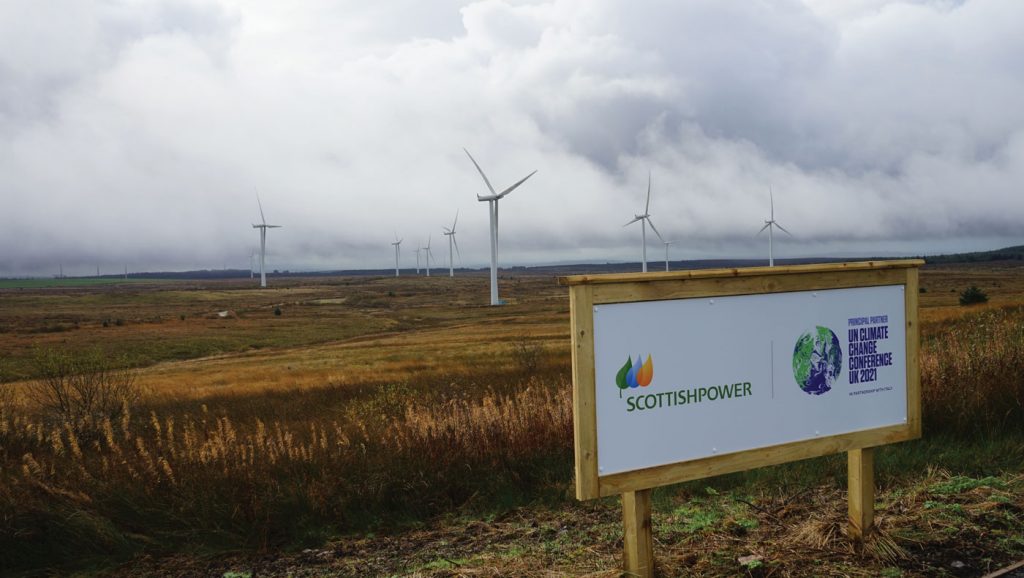
However, wind farms can detrimentally impact the land and ecosystems – the mills are prone to wildlife strikes as they may interfere with bird and bat migration paths, for instance. ScottishPower has taken this into account in its operations, seeking to maintain an optimum balance between respecting the ecosystem and answering energy demands.
ScottishPower takes the responsibility as a developer really seriously, and managing and mitigating any potential environmental impact on sites like Whitelee is a huge part of the process. We’ve got a detailed environmental and habitat management plan that makes sure we look after the wildlife, the peatlands, and everything around this site and make sure that that’s managed in the best possible way.
Denise Robertson
Head of Media Relations, ScottishPower
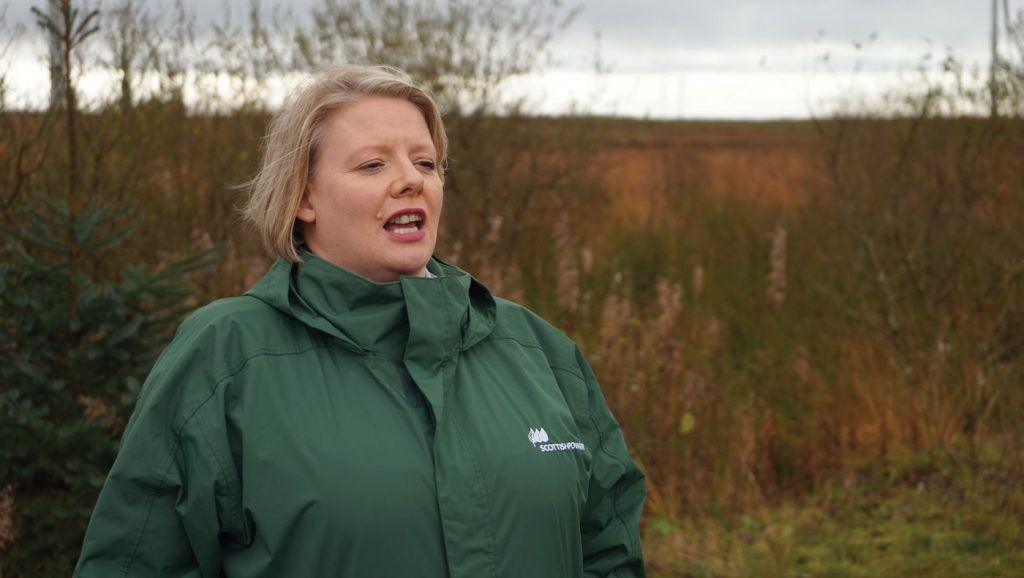
The Sunday excursion brought an uplifting note after the first week of COP26. Nonetheless, the onslaught of pessimistic forecasts concerning climate-related loss and damage reports would surge once more during the second week, beginning on November 8, set as Adaptation, Loss and Damage Day at the summit.
10. The Role of Land
On November 8, the Tzu Chi team held a press conference focused on climate change land-related issues, featuring aid and initiatives by Tzu Chi and two other organizations. Jan Wolf, a Tzu Chi Germany volunteer, moderated and opened the discussion by pointing out that land is a critical component in climate change:
Because of climate change, there’s a lot of land degradation, and there’s a lot of threat to our natural biosphere and ecosystems. Land is also a very important storage of carbon. And at the same time, because of climate change, we have a lot of problems in this world because of the degradation of ecosystems which leads to lots of further problems like food insecurity, migration, and even conflict in certain areas.
Jan Wolf
Tzu Chi Germany Volunteer
Tzu Chi SDG Action Team Member
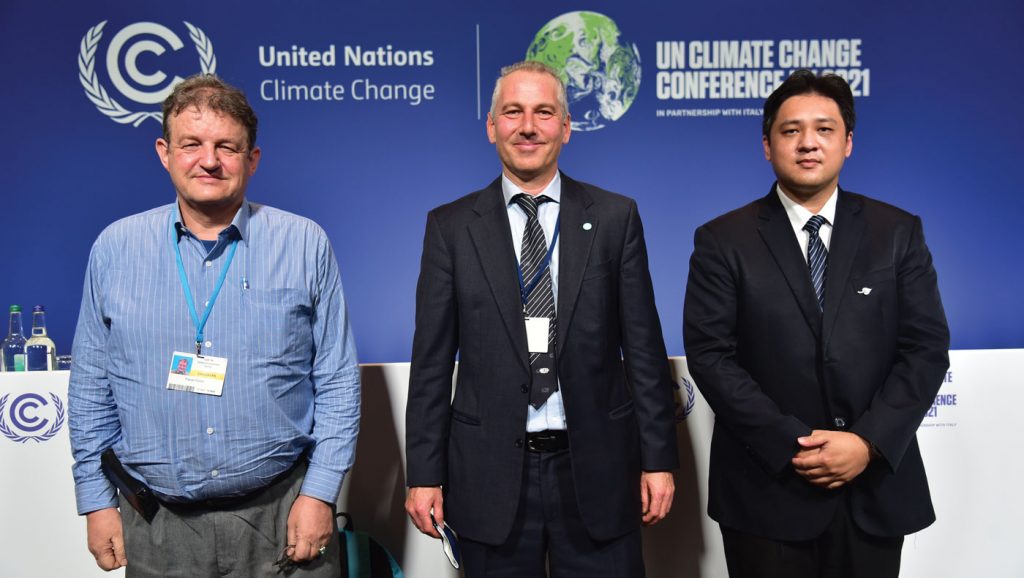
That’s why Tzu Chi brought this topic to the table. “If you look at these climate conferences, a lot of discussions here are about fossil fuels, how to reduce the carbon, how to get rid of coal, oil, and gas, but what has been overlooked is the role of land,” Wolf explained. As it is, habitable land is scarce. At the same time, the world’s population keeps growing, while the increasing number of climate change-related hurricanes, flooding occurrences, droughts, fires, and rising sea levels are making certain areas unlivable.
The first speaker, Faizal Parish, Director of the Global Environment Centre in Malaysia, revealed how this degradation is playing out in the peatlands, which represent only 3% of land on earth but hold about 30% of all the carbon stored in soils, and reported on measures to restore and preserve them. The peatlands are very vulnerable to drying due to drought, which is a climate-change issue, and threatened in other ways.
“In Southeast Asia, we’ve been facing a very significant challenge of land and forest fires throughout the region, and many of these fires are in the peatland ecosystems. These fires are causing very massive greenhouse gas emissions, estimated up to two billion tons of CO2 equivalent per year, which is a very significant portion of greenhouse gas emissions globally,” Parish recounted.
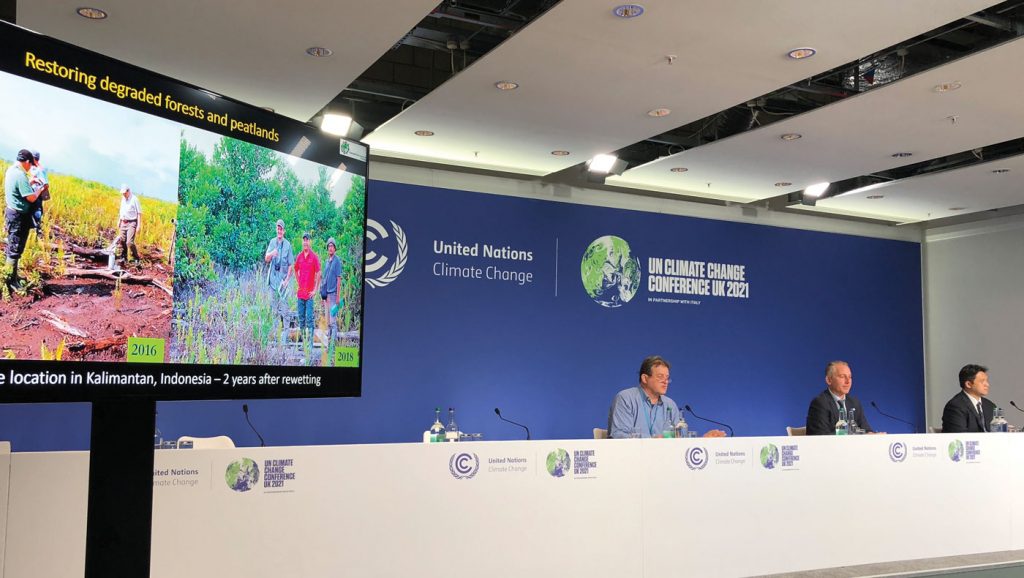
The cause of the fires is related to climate change and linked to slash and burn land clearing for large-scale contract farming to supply maize for the global feedstock market. The blazes burn up to 40 million hectares of land per year and create smoke clouds and 90% of the transboundary haze that affects five countries in Southeast Asia and the health of more than 50 million people – with an estimated 100,000 premature deaths due to severe smoke haze just in 2015. And there’s more:
The degradation of peatland ecosystems through fire and other rid means also is leading to the loss of very significant and unique biodiversity, as well as disrupting food supply for local communities, and water resources for broader areas and the national level.
Faizal Parish
Director, Global Environment Centre
In response to this plethora of problems, the Global Environment Centre has worked for over 20 years with stakeholders from the government, private sector, and local communities to promote better land management. However, the strategies mapped out must be reflected in country action plans and programs and implemented. Alas, that’s where many challenges at the national and local level emerge in terms of resource availability, capacity, and conflict with other sectors actively opening peatlands for plantation, agriculture, and other purposes.
There have been steps in the right direction within the private sector, such as the framework implemented at a Roundtable on Sustainable Palm Oil, stopping member organizations from developing new plantations on peatlands from 2008 and requiring best management practices in existing ones. And, there has been some progress in restoring peatland forest in areas denuded and burned in association with plantations.
The current strategy is to empower local communities. As Parish highlighted, “very often the local communities who originally or traditionally were stewards of these landscapes, and depend on them for resources, can play a very significant role in the protection, rehabilitation, and management of these areas, provided that the government and local authorities allow that.”
Topics
- 1. Nature in Peril
- 2. A Vigil to Set the Tone
- 3. The Earth Doesn’t Belong to Humanity Alone
- 4. We Need Action and Now
- 5. Exhibiting Tzu Chi’s Compassionate Technology
- 6. Youth Doing Their Part
- 7. A Powerful Alliance to Spur Change
- 8. Marching for Climate Justice
- 9. Learning About Scotland’s Renewable Energy Success
- 10. The Role of Land
- 11. Africa’s Intensifying Food Crisis
- 12. Faith-Based Climate Action
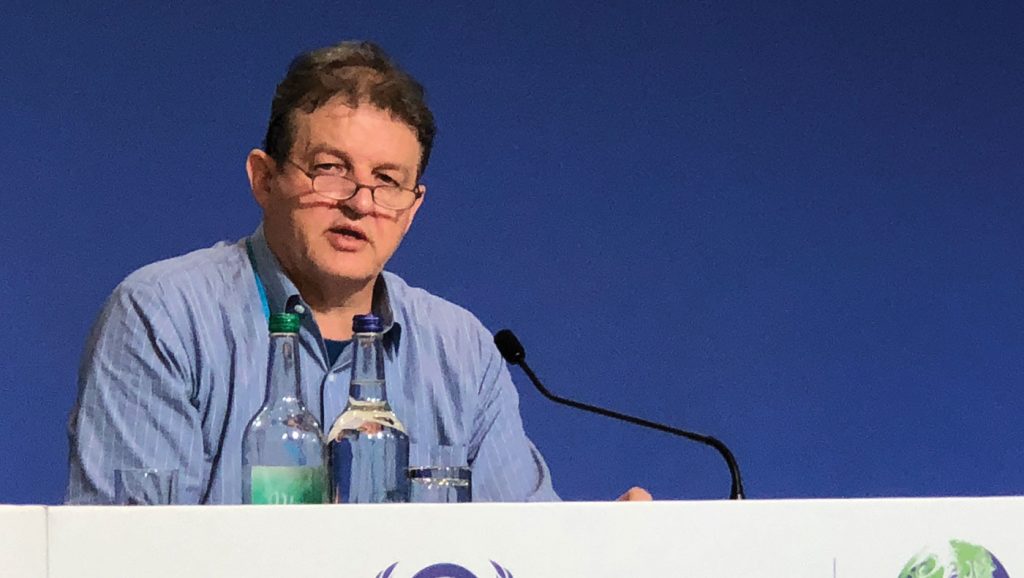
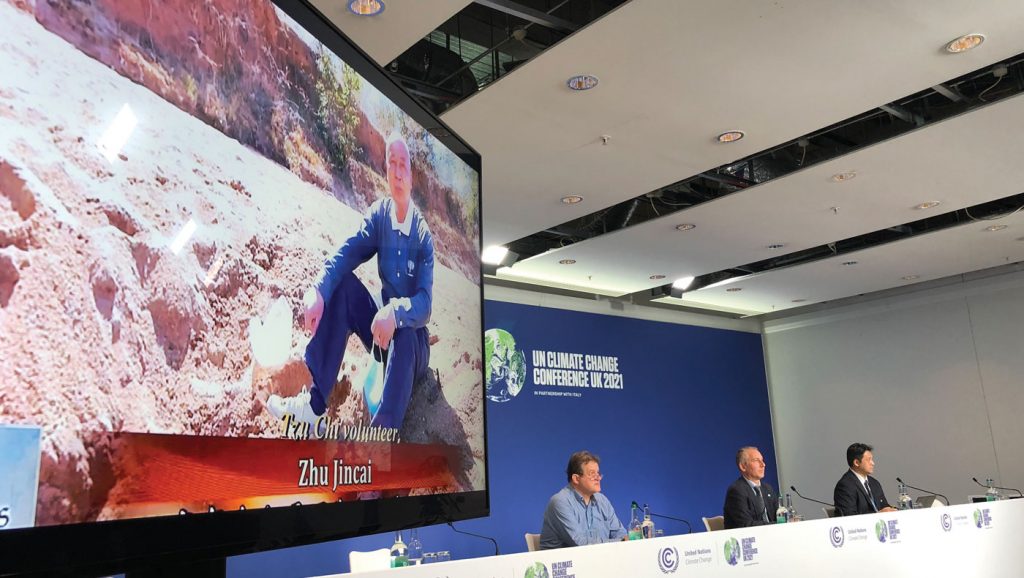
Such community action can help restore peatland areas, prevent fire, and restore livelihood benefits. Parish ended off by expressing the hope that resources to cope with loss and damage in regions affected by climate change would become available during COP26, but that would not be the case by the summit’s end.
Jimmy Yang, Special Project Lead with the Tzu Chi SDG Action Team, presented next and talked about land transformation in Zimbabwe through community engagement, reaffirming the importance of local involvement that Parish touched on. He began with a DaAi TV news clip illustrating Tzu Chi’s aid in a village in Zimbabwe where people are suffering from a lack of water for drinking and irrigation and such extreme food insecurity that some resort to eating ants to survive.
The situation in Zimbabwe is quite dire, with eight million people facing starvation as a result of the ongoing drought which has been happening since 2018. The land has become so arid that nothing can grow. Food needs to be purchased in large quantities from other parts of the country, and is too expensive for much of the population.
Jimmy Yang
Special Project Lead, Buddhist Tzu Chi Foundation
Tzu Chi SDG Action Team Member
Tzu Chi’s assistance began with finding a water source and building a well, which led to an evolving aid program addressing a glut of bananas that started during the COVID-19 pandemic. Local merchants were purchasing large amounts of bananas for sale in areas where people couldn’t afford to buy them. The fruit was left to rot, the food spoilage wasteful and adding to greenhouse gas emissions while leaving the population lacking nourishment.
Tzu Chi volunteers began by helping the local community process bananas on the verge of spoilage into chips and bread. That led to working with local farmers to compost rotting bananas, teaching proper composting techniques, particularly aerobic processes, or hot composting, which rely on oxygen rather than bacteria to break down the waste. This process reduces greenhouse gas emissions and produces rich, ready-to-use soil within six weeks rather than six months.
The final result was a fertile plot of land capable of growing vegetables and five types of grains. Over the course of about six months, the composed rotten bananas supported the growth of nutritious vegetables to feed over 700 households in the village, around 3,500 people.
While this is a success story, Yang cautioned that so much more humanitarian aid is needed where food systems are fragile, and starvation on a grand scale constantly threatens. He concluded by saying, “Our policies and strategies must be anticipatory, rather than reactionary. And we must use real technical solutions, real strategies with a close working relationship with local communities.”
The last speaker, Elinor Crescenzi, from the Los Angeles-based ECOFARM Initiative, joined in via a prerecorded video message about building an ecological and community-oriented land management movement in urban areas of developed countries. The Initiative strives to shift the way we engage with local lands, through attention to human integration with ecological and community systems, in ways “where we don’t see ourselves as separate from nature, but as part of nature.” It involves creating spaces that sustain human systems as well as the ecosystems of animals, plants, and microorganisms within them.
Essentially, utilizing vacant land and unused spaces affiliated with faith communities, schools, or parks, the venture is establishing a network of small, hyper-local composting farms that sustainably and visibly meet human needs for food, green space, and community. ECOFARMs promote new sources of organic, affordable, and accessible fresh produce while creating welcoming gathering spaces for humans and all forms of life. Concurrently, they facilitate clean and sustainable waste disposal, helping to restore soil fertility while enhancing community environmental awareness and knowledge.
We need to “reimagine the empty and barren as full and vibrant” and to “transform the industrial and destructive to productive and community-scaled,” Crescenzi said. The ECOFARM Initiative is currently working in a limited capacity in California through a state-funded pilot supporting 130 small-scale composting projects embedded in green spaces and communities, yet hopes to scale the model further.
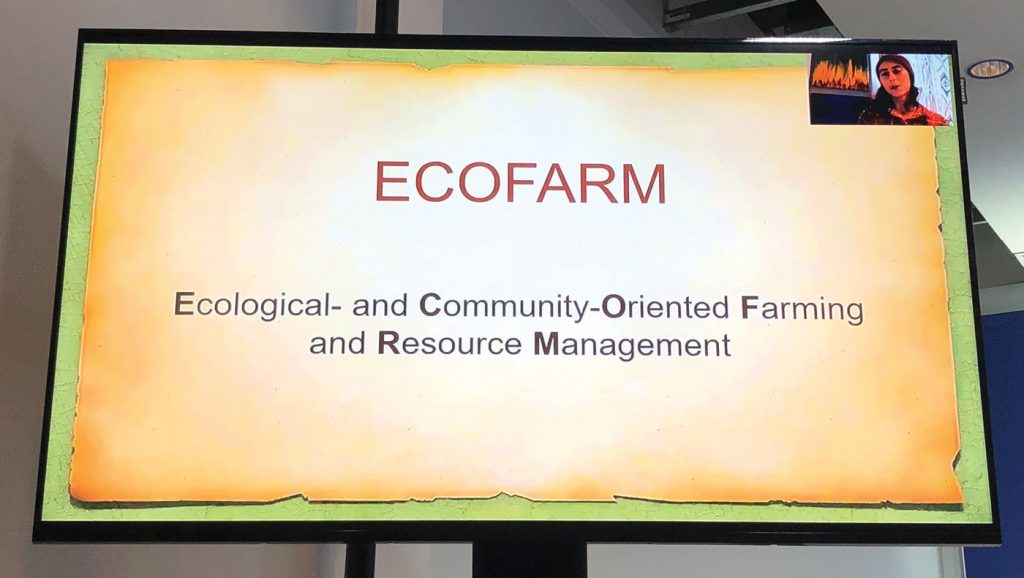
To conclude, Crescenzi, upheld the potential of increasing environmental awareness, which leads to support, and change:
The time to inform is now. The time to inspire is now. The time to act is now.
Elinor Crescenzi
ECOFARM Initiative
11. Africa’s Intensifying Food Crisis
On November 10, the Tzu Chi SDG Action Team held another press conference, moderated by Tzu Chi Germany volunteer Jan Wolf, expanding on the food crisis in Africa and Tzu Chi’s efforts to bring relief. “We’ve been active in Africa since 1993, and have organized charitable goods distributions, mobilized local volunteers, and worked with local communities and government leaders on various farming initiatives to improve disaster resilience,” he said in opening the session.
However, the scope of needs is vast if we consider statistics from the latest State of Food Insecurity and Nutrition Report, a summary published by the Food and Agriculture Organization of the UN every year:
We now have about 811 million people in the world who are facing hunger [and] about 282 million are from Africa [where] about 21% of the population is currently hungry and doesn’t have enough food. And if all our planet is heating up further, this number [will probably] rise as climate change is making things even worse.
Jan Wolf
Tzu Chi Germany Volunteer
Tzu Chi SDG Action Team Member
The first speaker, Dr. Cristina Tirado, Senior Policy Lead for Resilience with the World Food Programme (WFP), joined virtually. The WFP is the world’s largest humanitarian organization, saving lives in emergencies and using food assistance to build a pathway to peace, stability, and prosperity for people recovering from conflict, disasters, and the impact of climate change. Tirado confirmed Africa’s acute food insecurity issue with more statistics, stating that needs surpass humanitarian assistance groups’ capability.
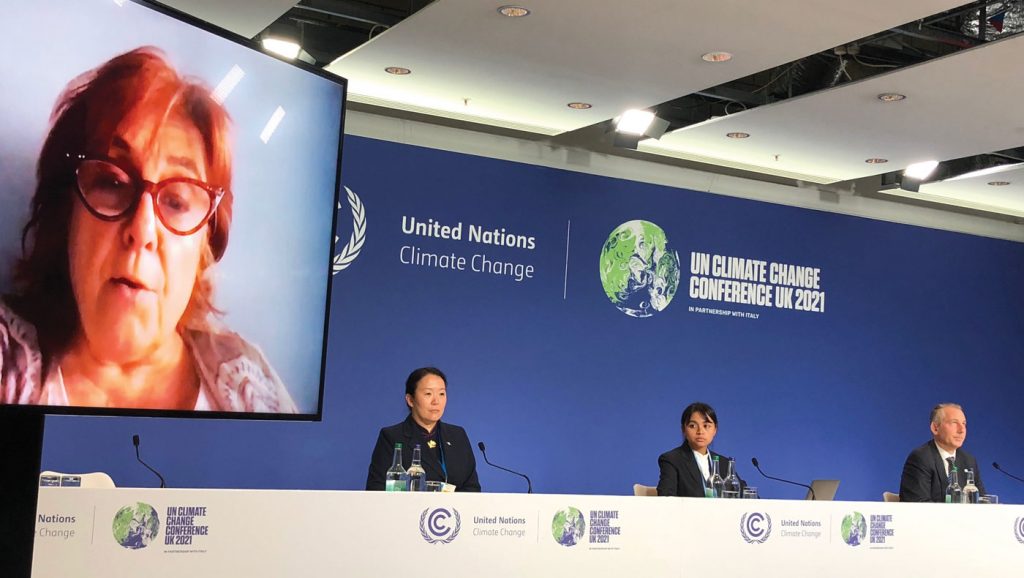
Tirado then spoke about the Climate Resilient Development Pathways Alliance created and introduced at the United Nations Food Systems Summit of 2021. The coalition is currently composed of most of the UN, 50 countries, and over 75 stakeholders, with all sectors invited to join. So far, interest in the Alliance has been expressed from research and think tanks, international financial institutions, farmers’ organizations, civil society, the private sector, partnerships and intergovernmental organizations, indigenous peoples, youth, and women.
The main thematic action areas under the Alliance are climate adaptation, mitigation and resilience, the water-food-energy nexus, modern/clean cooking, climate risk reduction and management, and the integration of resilience in international and national policies, plans, and initiatives. The Alliance also aims to engage the most vulnerable and high-risk areas, including small island developing states, arid and semi-arid lands/deserts, and the least developed countries.
“I’d like to invite all the stakeholders that are working on building resilience to think where you are going to join forces to work together in this,” Tirado said. She was also pleased to share that the framework was integrated within a Special Report of the UN’s Intergovernmental Panel on Climate Change (IPCC) and will be one of the principal components in the following assessment report.
Ashley Yong, representing Tzu Chi, spoke next. As the team had already presented aid in Zimbabwe the day before, Yong focused on Sierra Leone in West Africa. Since 2015, Tzu Chi has been helping people cope with food insecurity through community development projects aiming to provide immediate aid while empowering, educating, and strengthening resilience.
Sierra Leone has faced many challenges, from a civil war between 1991 and 2002 to the Ebola outbreak in 2015 to 2016 and frequent floods and mudslides that severely impact agricultural production. “The country is also highly vulnerable to climate risks, so as global warming continues to happen, the country is expected to face more food insecurity issues,” Yong reported.
Tzu Chi’s aid began with an immediate short-term emergency response entailing distributions of rice and daily necessities. It is now entering a long-term assistance plan to empower the population towards agricultural production self-sufficiency to ensure food security is in its own hands. Tzu Chi has been distributing 800 tons of rice every year. However, in 2022, the plan is to produce 400 tons of rice locally in collaboration with the Ministry of Agriculture and local partners such as Caritas Freetown, Healey International Relief Foundation, and the Lanyi Foundation.
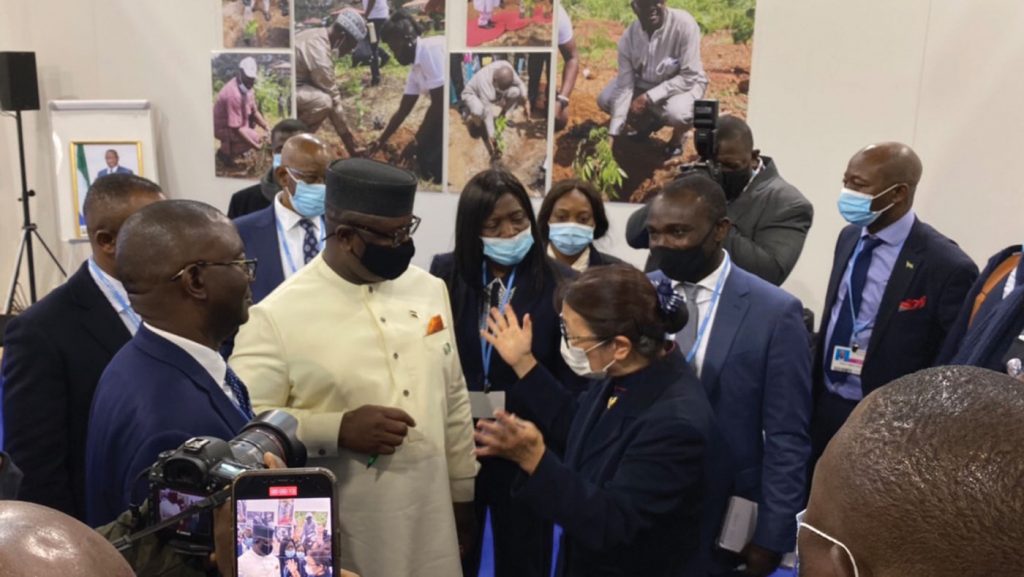
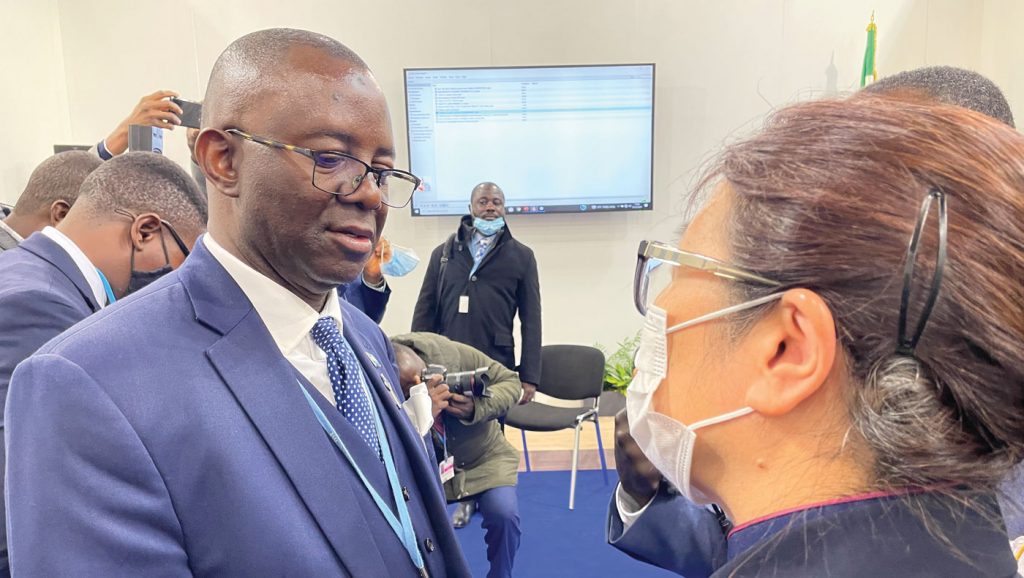
“In terms of agriculture, one of the challenges they face is low-yield production due to lack of resources, lack of support, lack of skills among the community,” Yong said, so the aid strategy takes that into account. To reduce overdependence on rice as a staple, growing a broader range of foods and encouraging the planting of cassava, which is more climate resistant, is part of the plan. Moreover, as in all its aid worldwide, Tzu Chi is focusing on those in greatest need of support:
At the Buddhist Tzu Chi Foundation, we target small-scale and woman farmers who are the most vulnerable in agriculture production.
Ashley Yong
Program Manager, Buddhist Tzu Chi Foundation
Tzu Chi SDG Action Team Member
In Africa, aside from Sierra Leone and Zimbabwe, Tzu Chi also provides aid in Lesotho, Namibia, Botswana, Zambia, Eswatini, Senegal, Malawi, Uganda, South Africa, and Mozambique. The next speaker, Lydia Wang, Deputy Director of Tzu Chi UK, presented Tzu Chi’s aid in Mozambique to improve food security through farming skills training and other means.
“In 2019, Mozambique was hit by Cyclone Idai, but the disaster didn’t end there. They also suffer from droughts, floods, pests, and in January 2021, they were hit by two cyclones,” Wang conveyed. As in other countries, Tzu Chi’s aid began with emergency relief, food packs containing basic staples like maize flour, rice, oil, sugar, and salt distributed to over 17,000 families. Yet thinking more long-term and seeing the agricultural potential in areas hit by Idai, Tzu Chi launched a community farming project.
The Great Love Farm began with a donation of seeds, a lease of approximately five acres of land at no charge, and the recruitment of locals interested in joining who then received farming and management skills training. During the COVID-19 pandemic, since Tzu Chi volunteers’ ability to travel was reduced, “the local residents started to take up ownership of the farm and inspire more people to join,” Wang recounted. That enthusiasm helped the farm expand to nearly 47 acres.
Irrigating so much acreage can be challenging, and the water supply is also an issue in Mozambique. Yet, with the combined effort of more than 2,000 people participating in the project, they manage to do it. A youth group also produced information sheets for residents, one about the crops and another detailing harvest distribution. Such transparent management systems build confidence and trust in this being a fair system.
Finally, since the agriculture sector is highly climate-sensitive and extreme weather can drive families into poverty, children may be deprived of school because they need to help out. By alleviating an insufficient food supply, children’s return to school becomes more feasible. The benefits of the farm are far-reaching, indeed.
With the successful model of Great Love Farm, the local volunteers are trying to reach out to more nearby villages and invite them to join this initiative. Alone we go faster, but together we go further.
Lydia Wang
Tzu Chi UK Deputy Director
Such a community support approach is at the heart of Tzu Chi’s aid vision. In conclusion, Jan Wolf summarized, saying, “Our goal is really to change people on the ground and to empower them to self-sustain, and this is the main principle and concept of Tzu Chi which we apply worldwide.”
12. Faith-Based Climate Action
On November 11, near the summit’s conclusion, Tzu Chi held its final press conference, entitled “Interfaith Reflection on COP26 and the Road Forward.”
Tiffany Tu opened the session on behalf of Tzu Chi:
Protecting our earth is a core value of many faiths. The stewardship arises from a deep connection with nature and all beings, a responsibility, a mission to be the voice and the caretakers of our land, people, and all living things, from the animals to the trees. Faith organizations can no longer be reactive. Instead, we have and need to continue to be proactive in this battle.
Tiffany Tu
UN Task Force, Buddhist Tzu Chi Foundation
Tzu Chi SDG Action Team Member
Valériane Bernard, a Brahma Kumaris representative to the United Nations, then shared about the Interfaith Liaison Committee (ILC), of which she is Co-Chair. The ILC was established during COP19 in 2013 as a Special Group under the UNFCCC (United Nations Framework Convention on Climate Change) to support the informal gathering of faith-based organizations and provide a platform to facilitate dialogue and action.
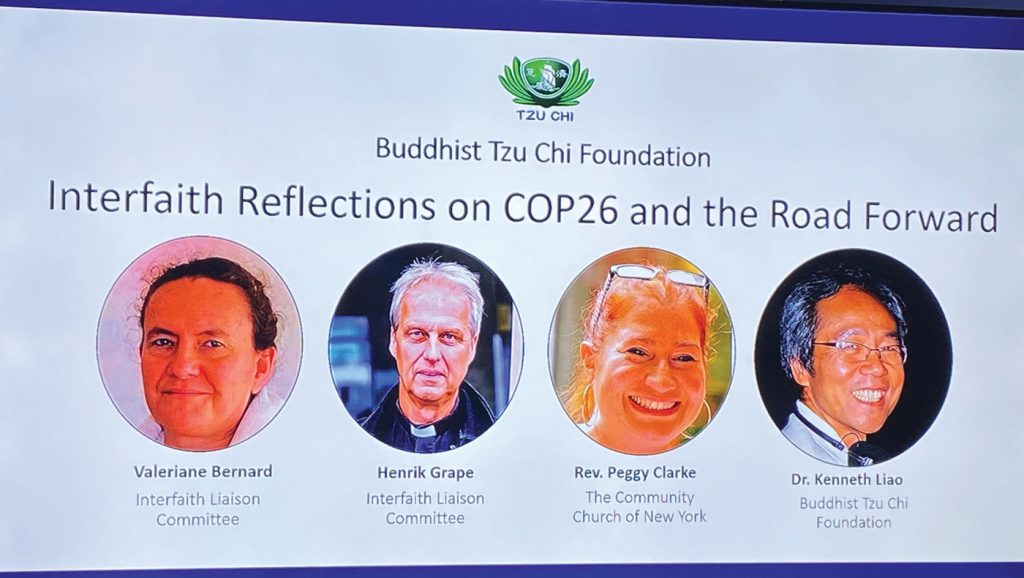
The Interfaith Liaison Committee took into its hand the fact that we wanted all the different faiths to unite, come together, and be able to have a deep conversation on the challenges that are present within the climate crisis. We wanted everyone from the grass root or higher up in the hierarchy of their religion to be able to have a deep conversation on the issues we’re all facing.
Valériane Bernard
Brahma Kumaris UN Representative
Interfaith Liaison Committee Co-Chair
On the first day of COP26, the ILC held a Talanoa Dialogue, Talanoa being a word used in Fiji and across the Pacific to reflect a process of inclusive, participatory, and transparent dialogue. This ILC tradition began at COP23 in 2017, and this year, 200 people participated in person or online. The ILC shared the fruits of the conversation with the UNFCCC leadership, as Henrik Grape, from the World Council of Churches and the Co-Chair of ILC, detailed next.
Grape began by illuminating that faith communities are often missing in discussions of how to come to terms with climate change and need to come together on this:
We’re in a very special position when humanity is actually having a great impact on the whole global ecosystem. It never happened before, and those moral and ethical decisions we make today have a large impact on the future. So that is also why I think the faith community is an important part of this.
Henrik Grape
World Council of Churches
Interfaith Liaison Committee Co-Chair
He called for a value-driven approach and inquiry as to, “What are the values that drive us to actually do the things that we have to do in a very urgent situation?” “All faiths on earth are more or less dealing with the question of ‘Why are we here, what is the meaning of being here, and where do we want to go?’” he elaborated. What is also essential to faiths is to “‘Love each other, take care of each other,’ but also what we could call justice, and to protect the most vulnerable.”
Grape shared that this year’s ILC Talanoa conversation touched on the need for advocacy based on the obligation to bring those on the frontlines of climate change, who can’t be in the room, to the discussion. There must be a place for the poor, the vulnerable members of faiths, and people of less voice, like youth, and all the species without any say – Mother Earth’s creation.
The group additionally highlighted that mitigation and finance must go together and address loss and damage – especially in the Pacific, Africa, Asia, Latin America, regions without the resources to cope with climate-related disasters. Issues around gender, human rights, and global governance also emerged. And, the fundamental need for spiritual voices to join the international climate dialogue was an essential part of their message:
If 82% or 83% of the world’s inhabitants say they belong to a religious tradition, this crosscuts every sector. This system of UN advocacy also should have some kind of ethical reflection over what they’re doing. If faith communities can contribute more to these dialogues, I think it will have greater success to actually implement what we need to do to keep the world under 1.5°C.
Henrik Grape
World Council of Churches
Interfaith Liaison Committee Co-Chair
Reverend Peggy Clarke, Senior Minister at Community Church of New York and representing the Unitarian Universalist Association, spoke next. She opened by talking about the role of people ordained for religious duties and their vital moral voice.
I see clergy, really, as the white blood cells of the planet. Whenever there’s a wound or a hurt, clergy people move, we go where we need to be, we try to inspire and bring healing. It’s our work; it’s what we’re called to do. And it’s why we’re here because there is now a wound, and we’re called to inspire whatever healing we can. We’re often called to remind people of their own best selves and their own highest aspirations.
Reverend Peggy Clarke
Senior Minister
Community Church of New York
Clarke also brought a note of hope. “What’s interesting to me about this COP,” she said, “is that it feels like the moral voice is kind of already here,” as opposed to in Paris in 2015 when it seemed radical to talk about the most vulnerable, and loss and damage wasn’t on the table in most discussions. “It felt like a fight there to get our captains of industry and government to consider the implications for those who are suffering most, and I have to say, that doesn’t seem true here. It feels like the moral voice has been woven into the conversation.”
She closed with a rallying cry for compassion, something at the heart of Tzu Chi’s vision and mission as well:
Since we all understand the desperate need, and we all understand the requirement for everyone to be on board, now we need to start building capacity for compassion. We have brought everyone to this doorway, and it feels like, okay, now what’s next is we have to start working this particular muscle. Compassion is not a muscle that we collectively exercise, and so, what’s next, it seems to me, is to build that.
Reverend Peggy Clarke
Senior Minister
Community Church of New York
It was a fitting lead-in to the last speaker, Dr. Kenneth Liao, the Buddhist Tzu Chi Foundation’s Deputy Medical Director, who opened with the topic of compassion. “As a Buddhist organization, our philosophy at Tzu Chi is to build upon the foundation of loving-kindness and compassion. And we set out as our mission to relieve the suffering of all sentient beings, including creatures in the world,” he explained.
Liao pointed out that, “according to the United Nations Food and Agriculture Organization statistics from 2018, every day, every second, 2,256 animals are being slaughtered. In a day, that translates to over 220 million, and if you go to a year, it means over 80.6 billion animals are being slaughtered.” Thus, exercising compassion can begin with our dietary choices since a paramount way to protect living creatures is to abandon eating meat. The impact of this simple act of kindness extends far beyond caring for animals; it encompasses protecting the environment and mitigating the ravages of climate change, too.
A plant-based diet is ingrained in our principles [and Tzu Chi has] been successful in promoting a plant-based diet by integrating faith-based compassion and other values to the scientific facts of climate change.
Dr. Kenneth Liao
Deputy Medical Director
Buddhist Tzu Chi Foundation
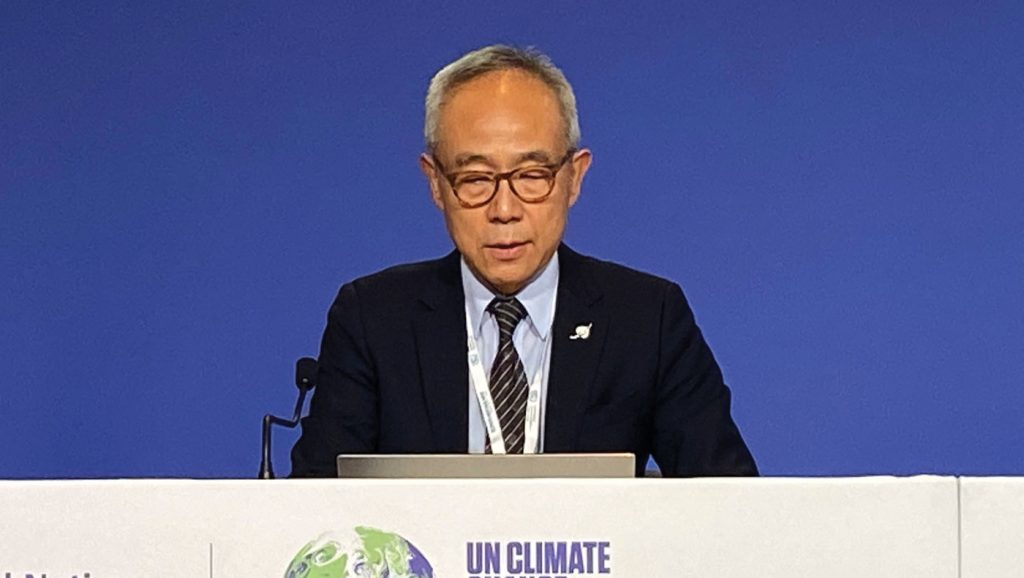
Looking at the road ahead, Liao invited everyone to adopt Tzu Chi’s all-in-one approach to ethics in practice as a way to good global citizenship:
“Ethical mind by volunteerism.
Ethical living by recycling.
Ethical eating by a vegetarian diet.”
Accomplishments and Disappointments
As COP26 drew to a close, everyone looked back at what had been accomplished by world leaders after two weeks of intense negotiations and debate and what had not. Among the concrete successes of the Glasgow Climate Pact, nations reached an agreement on Article 6 establishing the rules for carbon markets, completing the Paris Rulebook defining the Paris Agreement’s implementation.
There was cause to celebrate on the front of deforestation. Over 100 world leaders promised to end and reverse deforestation by 2030. More than 30 of the world’s biggest financial companies promised to end investment in deforestation-related activities, and 28 countries committed to removing deforestation from the global trade of food and other agricultural products.
Another historic success was that more than 100 countries pledged to cut methane emissions by 30% by 2030. Concurrently, some countries agreed to speed up their climate planning and release new “nationally determined contributions” every five years.
Certain nations committed to cutting heat-trapping pollution more drastically, although many didn’t agree to reduce emissions fast enough to avert the worst climate-driven damages. While delegates called for increased use of clean energy sources, they didn’t demand a full stop to the use of fossil fuels.
And, the unified plea by developing nations for climate justice fell on deaf ears. Although wealthier countries account for the majority of climate emissions while poorer nations suffer the most, financial compensation was not forthcoming and the $100 billion in “climate finance” already promised didn’t manifest. Instead, dubbed the “Glasgow Dialogue,” discussions between nations regarding how loss and damage funding might work will commence.
In the eyes of many, the COP26 conclusions fell short of hopes and expectations. We can only look ahead to COP27 in anticipation that it might result in more ambitious pledges of change and plans for implementation and action. But for now, the ball is equally in our court as individuals.
What lifestyle adjustments and sacrifices are we willing to make? After all, isn’t this precious planet that we all call home worthy of our deepest love, respect, and appreciation? And, we can no longer dodge this question: Will the requisite transformation of humanity’s attitude towards nature arrive before it’s too late?
SHARE:

